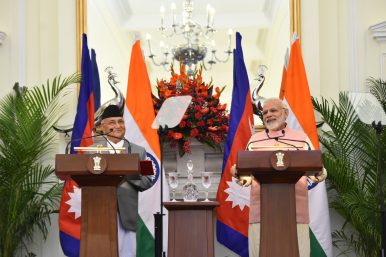By Udayan Das
 Three developments over the last month have enforced a renewed take on Nepal’s policies towards India and China. First, in a protocol treaty for the follow-up of the Transit and Transportation agreement, Nepal got access to Chinese ports, ending its dependency on India for third-party trade. Second, Nepal canceled the West Seti hydropower project with the Chinese organisation, Three Gorges Corporation, while restoring the Budhi Gandaki project back to the Gezhouba Group, reversing its decision to scrap the project 10 months ago. Third, while Nepal pulled out of the maiden Bay of Bengal Initiative for Multi-Sectoral Technical and Economic Cooperation’s (BIMSTEC) military exercise organized in Pune, India, it joined China in the second Sagarmatha Friendship exercise.
Three developments over the last month have enforced a renewed take on Nepal’s policies towards India and China. First, in a protocol treaty for the follow-up of the Transit and Transportation agreement, Nepal got access to Chinese ports, ending its dependency on India for third-party trade. Second, Nepal canceled the West Seti hydropower project with the Chinese organisation, Three Gorges Corporation, while restoring the Budhi Gandaki project back to the Gezhouba Group, reversing its decision to scrap the project 10 months ago. Third, while Nepal pulled out of the maiden Bay of Bengal Initiative for Multi-Sectoral Technical and Economic Cooperation’s (BIMSTEC) military exercise organized in Pune, India, it joined China in the second Sagarmatha Friendship exercise.
Nepal’s relations with its giant neighbors have often been translated as an arbitrary balancing act or a measure of normative non-alignment; however, these new developments depict an interplay between geography, deliverables and leadership in determining the courses of action with regard to India and China. Kathmandu’s foreign policy and the interlinkages of these variables become even more crucial as Nepal’s relations with India are on and off since the blockade imposed by India while its relations with China are in their ascendancy.
The fate of Nepal’s geography is a principal factor which has influenced its foreign policy decision-making. Landlocked between two of the world’s most populous nations, Nepal’s geography encounters risks, threats and opportunities all at once. While Nepal shares a special relationship with India through inherent people-to-people links and open borders, its biggest jolt in recent memory also came from its southern border in the form of a blockade amid a constitutional crisis. The blockade in turn was seen as punishment for diversifying its foreign relations and reaching out to China.
China has been interested in making steady inroads in Nepal and offered a seat on the Belt and Road Initiative (BRI) to boost that endeavor; meanwhile Nepal made sure that it receives the access to Chinese ports to end the Indian dependency for third-party trade. However, the sole availability of access to Chinese ports would do little for Nepal due to the constraints of the lack of connectivity along with an inconvenient border terrain. The nearest port is 2,600 km away and the lack of connectivity to the port through road or rail exposes the limits of utilizing those ports. The Sino-Nepalese deal is however indicative of shifting balances for New Delhi. The de facto route to the sea for Nepal still rests with India via Kolkata port due to the diktats of geography coupled with infrastructure.
Being one of the world’s poorest countries, Nepal needs to sustain its development by facilitating trade and other deliverables from India and China. While India has been a longstanding partner in terms of deliverables, its progress when it comes to completion of projects and political will has often been erratic. China on the other hand has been quick to express its interests in partnering with Nepal and making inroads in terms of investments. The issue of geography is also linked with deliverables. While the Three Gorges Corporation has backed out, citing high resettlement costs, India has further complicated the situation of hydropower projects for Nepal by stating that it will not buy electricity from China-sponsored and monitored electricity projects. What makes this crucial is that along with the curtains on the larger Indian market, transmitting electricity to China also becomes difficult with the terrain and the severity of the cross-border connections.
Kathmandu’s leadership and diplomacy has also been a major factor in determining relations with India and China. While geography is the existing factor and the deliverables are reactive, the leadership’s decisions on foreign policy are Nepal’s proactive variable. Prime Minister Oli’s healthy mandate was underpinned by anti-Indian rhetoric, but Oli has also vouched for mutual respect and equality as the norm between India and Nepal while emphasizing transactions and deliverables. China, on the other hand, is seen as a favorable ally, an option to counterbalance and neutralize India’s advantage. When it comes to connectivity, Oli seeks to transform Nepal’s narrative from landlocked to land-linked, connecting to the seas from both north and south. In the case of multilateral initiatives, Nepal is wary of being aligned with any block militarily, leading to it pulling out of the BIMSTEC military exercise. Nepal has also been pushing for SAARC to regain functionality and complement BIMSTEC in South Asia against the wishes of India.
As Nepal plays out its cards with its neighbors, it has in turn also become the theater of a competition between India and China. Having open borders with Nepal, India is wary of China knocking at its doorsteps through Nepal. Meanwhile, Nepal is crucial to a Chinese foothold in South Asia and furthering the BRI. Nepal’s strategies against this backdrop rests on how well it adapts to the geography, responds to the deliverables, and directs its leadership to secure national interests.
Udayan Das is a Doctoral Candidate at the Department of International Relations, Jadavpur University, India.
No comments:
Post a Comment